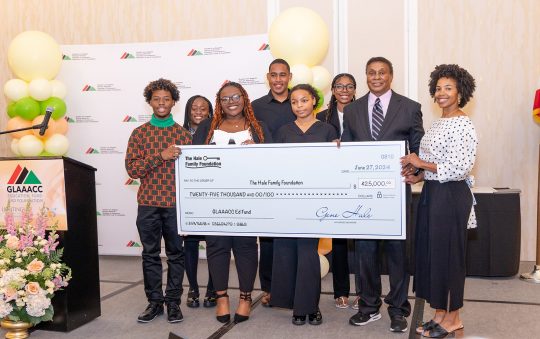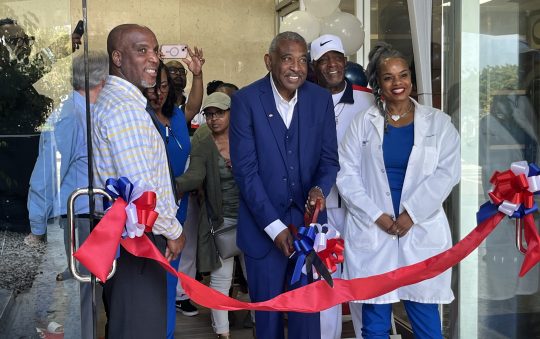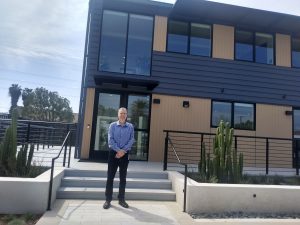
About a handful of rainstorms ago, on January 30, Lieutenant Governor Eleni Kounalakis joined with Southern California Gas Co. (SoCalGas) to unveil the future of what all that water can do, particularly vis-å-vis clean energy.
As part of their longstanding mission to find innovative ways to invest in energy even amid the formidable COVID-19 pandemic, SoCalGas envisioned an initiative in 2020 whereby hydrogen would be blended into the natural gas system in a model residential home. The goal was to demonstrate how end users can effectively reduce greenhouse gas emissions by utilizing a blended fuel source.
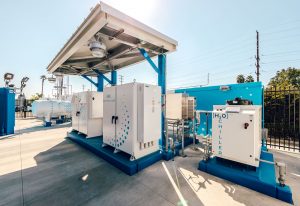
Eighteen months later, with the help of L.A.-based modular homebuilder Connect Homes, North America welcomed its first clean, renewable microgrid and home, H2 Innovation Experience ([H2]IE), in the city of Downey. It offers the potential to reliably power entire neighborhoods, day or night, rain or shine, throughout the year.
“Innovative projects like the [H2]IE demonstrate how California is leading the clean energy transition,” said Kounalakis. “This first-of-its-kind project shows how clean renewable hydrogen and microgrids can help power homes, enhance grid reliability, and preserve and grow good-paying union jobs in our state.”
The project employs simple scientific logic and remarkable ingenuity. [H2] IE’s carport solar panel produces approximately 65 kilowatts of power. That electricity is fed into the battery energy storage system.
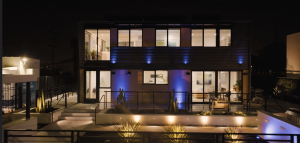
“That’s what we use to create hydrogen, and it’s called electrolysis. We feed water into that system, and electricity, and it creates a reaction. We extract the oxygen from the molecule, and basically, we have hydrogen.”
Greener, cleaner and ultimately less costly, this system can also afford end users unprecedented resiliency in the face of power outages. Electricity can only be stored for short periods of time, whereas hydrogen can be stored for two or three years and used on demand.
At the same time, with the on-site hydrogen fuel cell, hydrogen can be converted into electricity to power the home.
[H2]IE’s 2000 square foot prefab home features indoor and outdoor fireplaces, a barbeque grill and standard household appliances available at major retailers, all of which can be powered using this blended fuel source that cuts consumer costs and lowers greenhouse gas emissions. From the flame on the stove burners to the level of heat generated by the fireplaces, the overall efficacy isn’t at all diminished with hydrogen power.
An interactive “smart” table calculating potential savings associated with the use of blended fuel sources adorns one of the second-floor bedrooms of the house that has been purposed as a conference room.
In addition to modeling this green initiative for builders and developers, SoCalGas is planning outreach programs that will bring in school-age children to experience [H2]IE for themselves and fortify their education about sustainable and green practices. User-friendly touchscreen kiosks with headphones will be an added feature to these tours.
Contreras explained that innovative projects like [H2]IE often require out-of-the-box thinking. From the beginning there were challenges.
“We had labor shortages because people couldn’t go to the factories and build things, and supply chain issues,” he explained, emphasizing that the project begun in the early days of COVID-19. “In order to stay on track, we used an electrolyzer we had already. It’s an older model; we actually repurposed it from a previous project.”
Even the building of the system itself modeled sustainability. Sometimes “out-of-the-box” meant going out of the country. The hydrogen fuel cell had to be sourced from the UK. The overall concept was inspired by a similar project launched by a company in Australia.
Worth it in the end, [H2]IE brings the agency closer to the International Energy Agency’s (IEA) Net Zero Emissions Scenario 2021-2050. The IEA theorizes that hydrogen and hydrogen-based fuels could avoid up to 60 gigatonnes of CO2 emissions by mid-century, which is equivalent to 6% of total cumulative emissions reductions.
Contreras noted, “The greenhouse gas emissions that you’re saving without having to impact your home as far as your appliances go is a big, key driver that we want consumers to understand. Second, the technology of producing the hydrogen is rarely available, and the long-term storage is huge because we can save that energy for many years and use it during our really critical times that we need it.
“Resiliency. You’re not dependent on the grid. You have a blackout, rest assured, with this type of infrastructure and technology, at least you have your lights on, your fridge, you’re not going to spoil all your food. You’ll have your Internet still going.”
[H2]IE has been recognized by the Los Angeles chapter of the U.S. Green Building Council for its sustainable innovation, and it received a “World-Changing Ideas in North America Award” from Fast Company.



![SoCalGas Models Clean Energy with First-of-its-Kind [H2] Innovation Experience SoCalGas Models Clean Energy with First-of-its-Kind [H2] Innovation Experience](https://lasentinel.net/wp-content/uploads/sites/5/2023/04/5vSfyEcM.jpeg)
